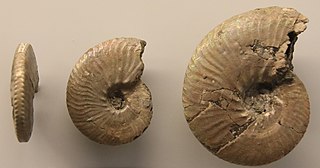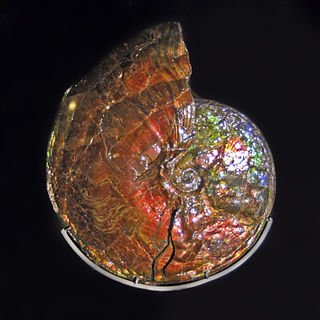The Albian is both an age of the geologic timescale and a stage in the stratigraphic column. It is the youngest or uppermost subdivision of the Early/Lower Cretaceous Epoch/Series. Its approximate time range is 113.0 ± 1.0 Ma to 100.5 ± 0.9 Ma. The Albian is preceded by the Aptian and followed by the Cenomanian.

Acanthohoplites is an extinct genus of ammonites in the family Parahoplitidae that lived in the Aptian and Early Albian stages of the Early Cretaceous.

Ammonoceratites is an extinct genus of ammonoid cephalopod known from the Albian of British Columbia, Madagascar, New Zealand, and Japan, included in the Lytoceratidae.

Anahoplites is a genus of rather involute, compressed hoplitid ammonites with flat sides, narrow flat or grooved venters, and flexious ribs or striae arising from weak umbilicle tubercles that end in fine dense ventrolateral nodes. The elements of their sutures are short, wide and jaggedy. Specimens of Annahoplites have diameters typically in the range of 4–6 centimetres (1.6–2.4 in) although some with diameters of as much as 19 centimetres (7.5 in) have been reported. The genus lived during the Cretaceous, from the Middle to the late Albian.
Beudanticeras is an extinct cephalopod genus from the Late Cretaceous period; Albian and Cenomanian, belonging to the ammonoid subclass and included in the family Desmoceratidae.
Zuluscaphites is an extinct genus of cephalopod belonging to the Ammonite subclass.
Uhligella is an extinct cephalopod genus from the Early Cretaceous, belonging to the ammonoid subclass and included in the Desmoceratidae.
Anisoceratidae is an extinct family of heteromorph ammonites which belong to the Ancyloceratina superfamily Turrilitoidea. Members of the family range is from the lower Albian to the upper Turonian. The family is possibly derived from a member of the Hamitidae.

Hoplites is a genus of ammonite that lived from the Early Albian to the beginning of the Middle Albian. Its fossils have been found in Europe, Transcaspia and Mexico. Shell has compressed, rectangular till depressed and trapezoidal whorl section. There are strong umbilical bullae from which, prominent ribs are branching and these are interrupted on venter. Ends of ribs on the venter are prominent and can be both alternate or opposite. Some species have zigzagging ribs and these ribs ends usually thickened, or they can be raised into ventrolateral tubercles. These tubercles are mostly oblique clavi.

Acanthoceratoidea, formerly Acanthocerataceae, is a superfamily of Upper Cretaceous ammonoid cephalopods belonging to the order Ammonitida, and comprising some 10 or so families.
Coilopoceras is a compressed, involute, lenticular ammonitid from the Cretaceous, with a narrow venter and raggedy ammonitic suture; type of the Coilopoceratidae, a family in the Acanthoceratoidea of the suborder Ammonitina.

Engonoceratidae is a family of typically compressed, more or less flat sided and involute ammonites from the mid Cretaceous belonging to the Hoplitoidea. shells have flat sided outer rims ( venters), at least in some stage. Single or branching irregular ribs and variably placed tubercles may occur. Sutures have numerous auxiliary and adventive elements of similar form, in general radially arranged. Forwardly divergent saddles tend to be simple, without subdivision. Lobes, pointing apically, may be simple and undivided or may be frilled with short irregular serrations.

Placenticeratidae is an extinct family of mostly Late Cretaceous ammonites included in the superfamily Hoplitoidea, derived from the Engonoceratidae by an increase in suture complexity.
Brancoceras is a rather small, strongly ribbed, acanthoceratacean ammonite from the Albian stage of the Lower Cretaceous, the shell evolute with a subquadrate whorl section and rounded venter. The suture forms a finely squiggly line with well-defined lobes and saddles. Brancoceras (Eubrancoceras) aegoceratoides reached a diameter of at least 4.2 centimetres (1.7 in).
Dipoloceras is a rather evolute, strongly ribbed and well keeled acanthocerataean ammonite from the Albian stage of the Lower Cretaceous included in the brancoceratid subfamily Mojsisovicziinae. The whorl section is typically inflated or depressed. Ribs are high standing, may be sharp, close to wide spaced. The ventral keel may sit below the level of the ribs.
Brancoceratidae is a family of acanthoceratoid ammonites from the middle of the Cretaceous, recognized by their commonly evolute shells with round, oval, or quadrate whorls, strong ribs, usual ventral keels, and at least, umblical tubercles. The family is thought to be derived from the Desmoceratidae (Desmoceratoidea), perhaps from Silesitoides or some allied genus.

Lytoceratinae is a subfamily of ammonoid cephalopods that make up part of the family Lytoceratidae.
Pseudohaploceras is a genus of desmosceratid ammonites from the Early Cretaceous; Valanginian to Albian epochs.
Melchiorites is a desmoceratid ammonite genus included in the subfamily Puzosiinae. Member species are characterized by an essentially evolute shell in which the early whorls are smooth, with sinuous radial or oblique constrictions but in which later whorls have feeble intermediate ribs on the outer part of the sides and venter.

The Riachuelo Formation is a geologic formation of the Early to Late Cretaceous age in northeastern Brazil's Sergipe-Alagoas Basin. It is the first Formation of the Basin to contain sediments deposited under fully marine conditions. The formation is subdivided into three members: Angico, Taquari and Maruim.








